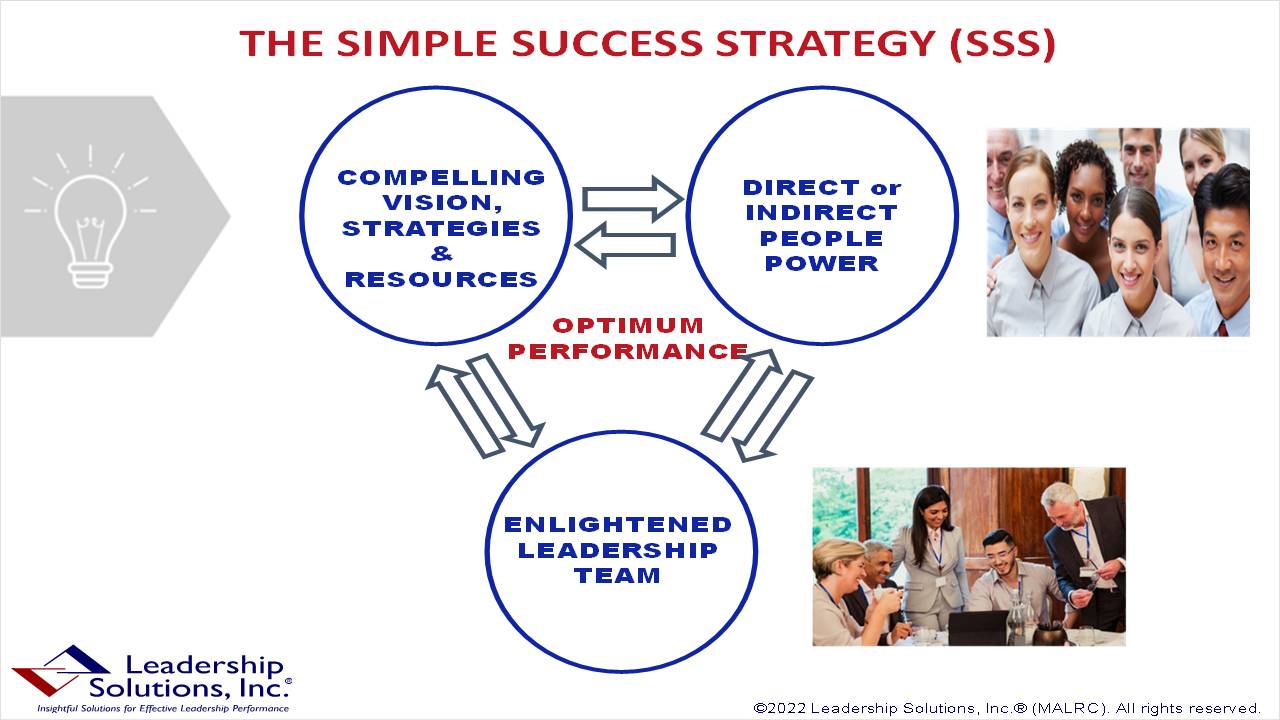by Peter A. Arthur-Smith, Leadership Solutions, Inc.®
“Having a compelling Vision is crucial, although it requires astute positioning and pathfinding to capitalize on that vision.”

It wasn’t difficult for Susan to entice her new found Strategist team back for a subsequent pathfinding session two weeks later. Its prospects for building a thriving SalesSMART Advisor organization were pretty compelling. It was evident that a clear market opportunity existed for better job on-boarding-orienting; especially for salespeople who are any firm’s most vital frontispiece. It’s also crucial for salespeople to meet their firm’s expectations, as their incoming revenues are part of a business’s life blood. Turnover among “newbie” salespeople is often 30-40%, which can undermine any venture’s growth momentum.
Alex encouraged Susan to be well-prepared for her leader-team pathfinding session, since he didn’t wish her to miss a beat in gaining momentum. Continuing to build on her volunteer Strategists’ commitment was crucial to encouraging them to stay the course. She also needed their insights and ideas to help flush out an exceptional way forward. Based upon the above team Simple Success Strategy, they already had their compelling Vision and Enlightened Leadership Team in place.
When they did get together, there was clearly great anticipation based upon Susan’s initial notes handed out at the end of their last session. She now went around her semi-circle of six participant Strategists and noted down on a flipchart – for all to see – what they considered were the most conducive factors helping SalesSMART’s likely success. She also noted what they felt needed further attention, rather than just dwell upon “what’s wrong.” Sustaining a constructive, positive tone to their session, without labeling things specifically as “what’s wrong,” would aid momentum and over-all motivation.
She then proposed – in line with Alex’s view – that SalesSMART’s success strategy needed to be built upon three key legs:
- A clear Customer Value Proposition
- Effectiveness rather than Efficiency and Heterarchy rather than Hierarchy principles
- Sourcing sufficient amounts of the right resources
With these in mind, she encouraged her team to self-select themselves into three “pairs” and to choose one of the three topics for each pair. To aid their deliberations, she and Alex had already put together three sets of outline briefing notes. Susan and Alex promised to circulate among them for the next couple of hours to help with suggestions, as the three pairs grappled with these vital strategic challenges.
In the case of Sarah – Expansionist – and Jeff – Promotionist, who naturally chose the Customer Value Proposition topic, they bullet-pointed what factors their customers would REDUCE – e.g. people-turnover and slow starts – and what ones they would INCREASE – e.g. faster sales and greater people-retention – by collaborating with SalesSMART Advisors. They also speculated about factors their customers would ELIMINATE – e.g. inadequate orientation and poor sales presentations – and CREATE – e.g. real sales pros and greater team motivation – by involving SalesSMART. Their conclusions from these four listings enabled them to arrive at a powerful, preliminary Customer Value Proposition statement. Have you ever done this?
With Malcolm – Innovationist – and Julia – Operationist, they chose the Effectiveness-Efficiency and Heterarchy-Hierarchy principles. They also bulletized their findings in the form of: With their first E vs E combination, they focused on innovation rather than squeezing and several more. In the case of their H vs H pairing; They listed centered-orchestration rather than driving things from the pinnacle, among others. Both alternative approaches would allow for more conducive and momentum-building environments.
When it came to Sheila – Humanist – and Mark – Provisionist, where they concentrated on sourcing sufficient amounts of the right resources – i.e. people as well as money: Susan gave them Alex’s chart depicting around sixteen different resource elements that a flourishing venture needed to both furnish and monitor. However, being a start-up, these two Strategists, prioritized what would be crucial “now” what would be more crucial later on. They felt SalesSMART Advisors already had sufficient motivated leaders, along with a desirable product-service and specialist know-how. Even so, the firm needed to build enough quality advisors and procure robust financing over time – placing emphasis on generic funding rather than outside investors.
After two hours of deliberation, Susan called them all back to their semi-circle, where the pairs sat next to each other. They put-up their various summarized flip charts. These enabled colleagues to review and make constructive suggestions to their listings. Susan and Alex constructively weighed-in, too. Such insights drew them all closer together, as well.
With these encouraging conclusions, Susan invited them to recess and take further time over the next two weeks to further refine their thoughts. With their “pathway” that much clearer, they broke-off for another well-deserved light lunch; enabling them to further interact and reflect upon their positive morning’s work.
There was still no discussion about calling upon outside funders, since it wasn’t necessary. Generic funding, wherever possible, is the preferred way to go. It minimizes debt and the prospect of having investors who are only interested in the numbers; rather the people and market expertise that really produces those numbers. Many highly successful companies didn’t need seed money up front – e.g. Microsoft, Google, Amazon, etc. – because they had the right product, vision and leadership competence at the outset.
And so, the team agreed to meet again in two-week’s time to address Phase 3 of their enlightened leadership (EL) startup journey – Engage and People Involve: “Alex prepares Susan to lead team discussions on Hiring and Motivating Future SalesSMART Advisors.”
